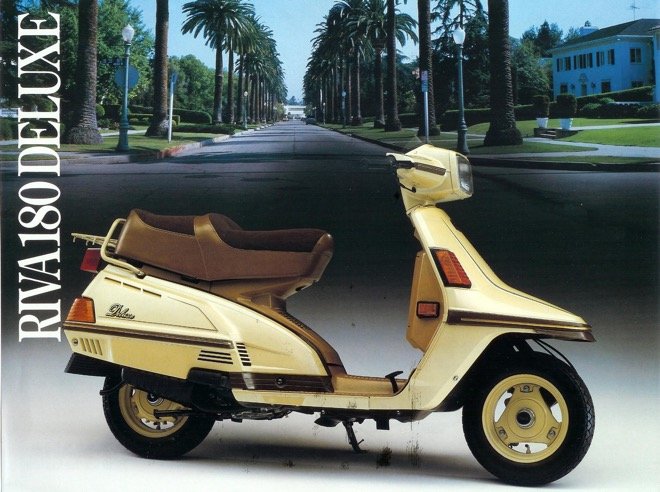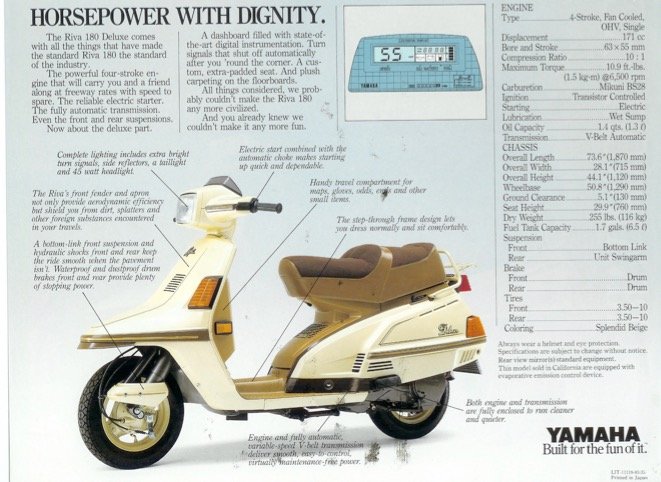YAMAHA RIVA 180 / 200 (XC180 / XC200)
Yamaha showed up in North American with the Riva 180 (model code XC180) for 1983, beating Honda to the large scooter market by a full year. The Riva 180 was a powerful 4-stroke scooter with a respectable top speed of 70-75 mph. This was similar to the 250cc Elite and Helix scooters Honda would introduce in the coming years. As a 180cc model, this Riva was sold from 1983 – 1985 and then it returned as the Riva 200 for 1987 – 1991.
Outside of the USA & Canada, this scooter was normally sold as the Cygnus 180 / 200. Yamaha continues to use this name today with a 125cc model.
Models
The Riva 180 was sold from 1983 – 1985. Over this span, Yamaha sold three versions; the regular Riva 180 (code XC180), an upgraded ‘Z’ version (code XC180Z) and then a ‘Deluxe’ version (code XC180D). All of the model codes are then followed by a letter corresponding to the year (1983 = K, 1984 = L, 1985 = N). So for example, a 1985 Deluxe Riva 180 would be model code XC180DN. The standard version of the Riva 180 was sold all three years, but the Z version was sold only in ’84 and ’85. The Deluxe version was only sold in 1985.
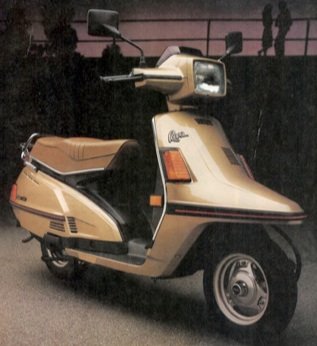
Yamaha withdrew the Riva 180 from our shore after 1985 but they returned for the 1987 model year with an improved Riva 200 (XC200) capable of 75mph. In addition to an extra 20cc, the Riva 200 had an improved dual sided fork, and improved auto choke system and a few other tweaks like new aluminum rims. This improved Riva was sold from 1987 until 1991, again in several trim levels. 1987 saw both a regular and ‘ZC’ version. Presumably the C stands for California, so maybe the Z version was only sold in California since just a Z version is not listed. In 1988 through 1991, both regular and Z versions were sold, except for 1990 when just the Z was available. Opting for the Z version netted you the same upgrades as mentioned early for the Riva 180 Z.
Motors
As the largest member of Yamaha’s Riva family, the Riva 180 / 200 packed some serious power. The Riva 180 was quite fast for its size with a top speed in excess of 70mph. 75 is achievable in good conditions. The Riva 200 added another 5 mph to the top speed and offers quite strong acceleration right up to 65 mph so it’s not a bad choice for casual highway riding.
The motor used in the XC180 / XC200 is a simple but rugged design. This single cylinder motor is air cooled, carbureted and uses 2-valves. The first iteration was 171cc, while the later was 199.7cc.
 Design and Amenities
Design and Amenities
The Riva 180 has a decent sized glovebox but unfortunately there is no storage under the seat. The large motor and under seat fuel tank occupy this space which is to unfortunate. Quite a few other large scooters from this era also don’t have underseat storage (ie. Riva 125, Honda Elite 150). The main ones that do are the Honda Helix and ’89-90 Honda Elite 250.
Yamaha sold quite a few neat accessories for their Riva 180/200 scooters including rear cases, a ‘streamliner’ windscreen and an unusual tennis racquet holder rack. I wonder what portion of Riva owners are also avid tennis players? Apparently Yamaha hopes quite a few are.
This scooter unfortunately used drum brakes front and rear. While not uncommon at the time, at least a front disc brake is now the norm so these big Riva’s don’t offer excellent braking. The front drum does the best job it can, but performance is still lackluster.
Discussion
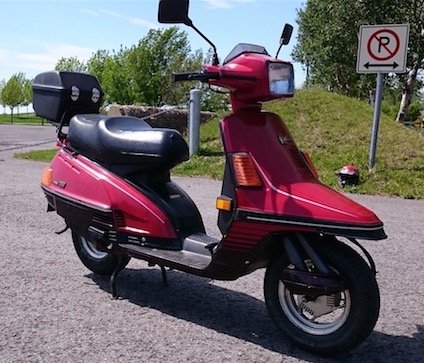
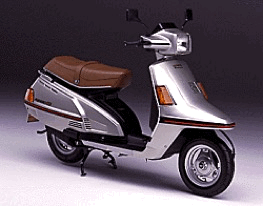
For more information on the Riva 180/200, check out this Yahoo! group. You need to sign up for Yahoo to access their group but they have complied an impressive collection of information that makes sign up worthwhile.
Pros:
- Fast
- Comfortable
- Nice glovebox
Cons:
- Notorious for autochoke problems.
- No underseat storage
Links:
XC180 Riva 180 / 200 Service Manual – Essential for working on your Riva scooter.
MotorscooterGuide Forums – Visit the forum on this site to chat about this scoot.
RivaRiders – Yahoo group of Riva 125, Riva 180 and Riva 200 owners.
JacksScooterShop – Great Info on the Riva 125 and all Japanese scooters.
Common Riva 180/200 Problems – From Jacks Scooter Shop, this describes common problems for the Riva 180 / 200.
Key Specs – Riva 180:
- Engine: Air cooled, 2 valve, 171cc, single cylinder, 4 stroke, single overhead cam
- Torque: 10.8 lbs-ft @ 6500 RPM
- Bore & Stroke: 63.0mm x 55mm (180), 68.0mm x 55mm (200)
- Compression: 10.0:1 (180), 9.5:1 (200)
- Carb: Mikuni BS28
- Length: 73.6”
- Width: 28.1”
- Height: 44.1”
- Seat Height: 29.9”
- Wheelbase: 50.8”
- Weight (Wet): 268lbs (180), 282 lbs (200)
- Oil: 1.1 qt (1.0 Liters) of 10w40 (warm weather) or 10w30 (cold weather)
- Maximum Load: 340 lbs
- Spark Plug: DPR8EA-9 (NGK) or X24EPR-U9 (Denso)
- Tires: 3.50 x 10 (Front and Rear)
- Tire Pressure: 21 / 28 psi (Front/Rear)
- Brakes: Drum / Drum
- Fuel tank: 1.8 gallons, 6.5 litres
- Front suspension: Bottom-link fork, 3.15” Travel
- Rear Suspension: Unit swing, 2.75” Travel
- MSRP: $1499 (1984 USA)
Colors:
- 1983: Mist Blue Metallic, Champagne Gold, New Silver Dust
- 1984: Mist Blue Metallic, Champagne Gold, New Silver Dust, Black Gold (Z trim)
- 1985: Black, Splendid Beige (Deluxe), Urushi Black/Black Gold (Z Trim)
- 1987: Bordeux Red, Sparkle Maroon, Urushi Black (Z Trim)
- 1988: Bordeux Red, Sparkle Maroon, Samson Blue, Urushi Black (Z Trim)
- 1989: Bordeux Red, Aurora Silver, Sparkle Maroon, Samson Blue, Urushi Black (Z Trim)
- 1990: Bordeux Red (Z Trim), Urushi Black (Z Trim)
- 1991: Bordeux Red, Sparkle Maroon, Marshall Gold, Urushi Black (Z Trim)
More Brochure Scans Here

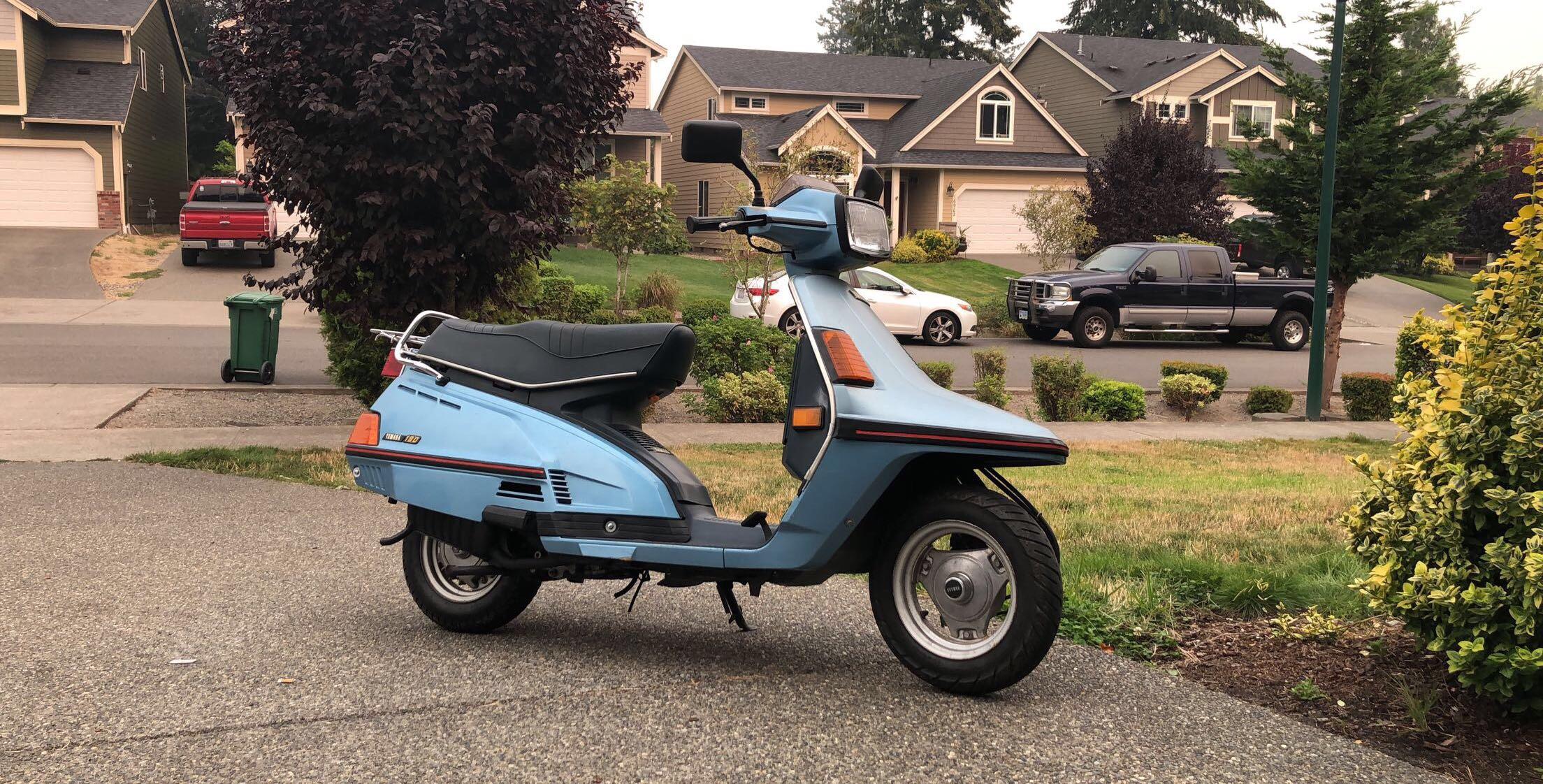
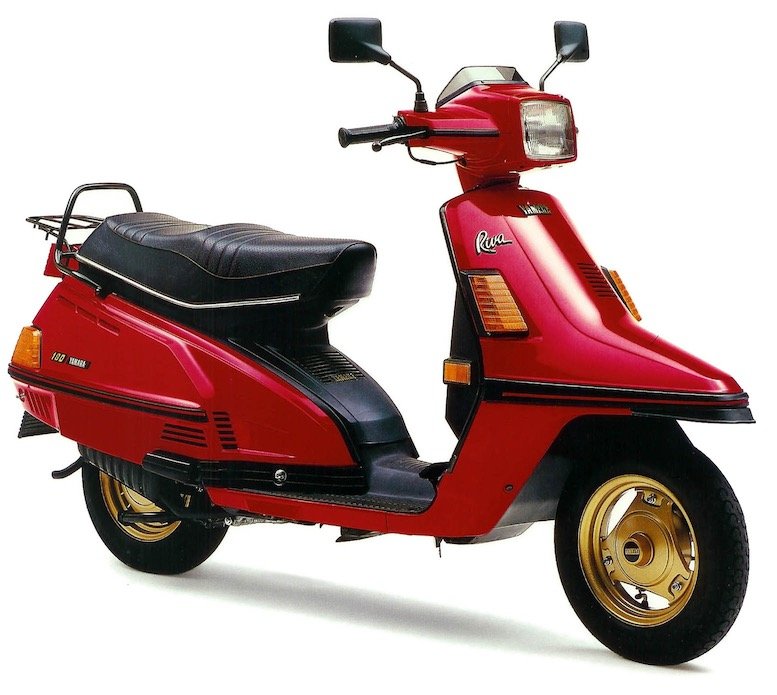
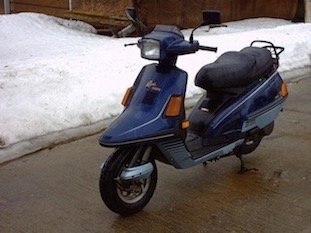 Design and Amenities
Design and Amenities